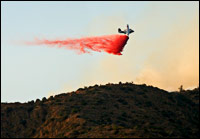Dear Umbra,
Nearly every day, I can hear slurry bombers (planes that dump bright pink goo at the edges of fires) zooming overhead. I think the bright pink goo is a flame retardant, which seems to recently have gotten a bad reputation as a carcinogen. Not only that, but folks who have dogs here claim their dogs get hot spots from playing in the rivers below where the goo is dropped. What’s going on? What is this stuff? Could it be harmful to firefighters or local communities? Is there anything being used anywhere else as an alternative? Thanks for any illumination you can provide.
Heather McKee
Missoula, Montana
Dearest Heather,
The ingredients in slurry, according to the U.S. Forest Service, are “85 percent water, 10 percent fertilizer (ammonia phosphate and sulfate ions), and 5 percent minor ingredients (iron oxide for color, clay, or bentonite).” But the exact mix differs a little each time. That’s because a person called a mixmaster is in charge of mixing up each batch, then loading it onto an aircraft that will visit whatever raging fire needs to be quelled. Slurry’s chemical base also includes things like stabilizers, thickeners, substances to inhibit corrosion, and that bright red dye. The dye reddens an area for about three months, so pilots and firefighters know where it’s been dropped already. A soaplike substance helps the slurry stick to vegetation.

Slurry with the cringe on top.
Photo: iStockphoto
It’s difficult to say if animals that play or live downstream from the slurrified sites will get ill, but even the Forest Service admits that the mix may be “harmful to pets if swallowed,” since they risk fertilizer poisoning. Though their website doesn’t get into it, I’d guess that wild animals could just as easily get sick from the stuff. As for two-legged types, I haven’t been able to definitively confirm nor deny the carcinogen rumor in my research. For what it’s worth, the Forest Service says the slurry is nontoxic to humans.
About 15 million gallons of slurry hits the ground in the U.S. each year, but this weapon in the fire-fighting arsenal is not typically employed until things get especially bad, as it’s an expensive one: the mixture itself costs about 70 cents per gallon, and air drops usually cost some $2 per gallon. A direct substitute would be greater reliance on other methods, such as dropping water from aircraft and purposely lighting what are called “backfires” — small fires that burn toward the bigger fire in order to remove its fuel source. One drawback to dropping just water is that it doesn’t last as long or stick as well as slurry — both bonuses after the fire is out, but not while it’s burning. On the other hand, water doesn’t have those pesky animal-sickening qualities, nor that three-month redness.
Long-range alternatives include improving forest health by simply letting fires in some ecosystems burn, and limiting grazing and logging in others. Another important thing is restricting the expansion of residential areas — if you’re moving anytime soon, stay away from the area sometimes called the urban-wildland interface, “where combustible homes meet combustible vegetation.” Also, as long as we’re listing alternatives, working to slow climate change wouldn’t hurt.
Ultimately, large fires will happen no matter what we do. A recent report to Congress [PDF] takes an uncharacteristically holistic view, saying “as long as there is biomass for burning, especially under severe weather conditions (drought and high wind), catastrophic wildfires will occasionally occur.” I think this means you can expect to see lots more slurry. On the other hand, it might mean Congress is about to do away with all our biomass. You never know these days.
Flammably,
Umbra

